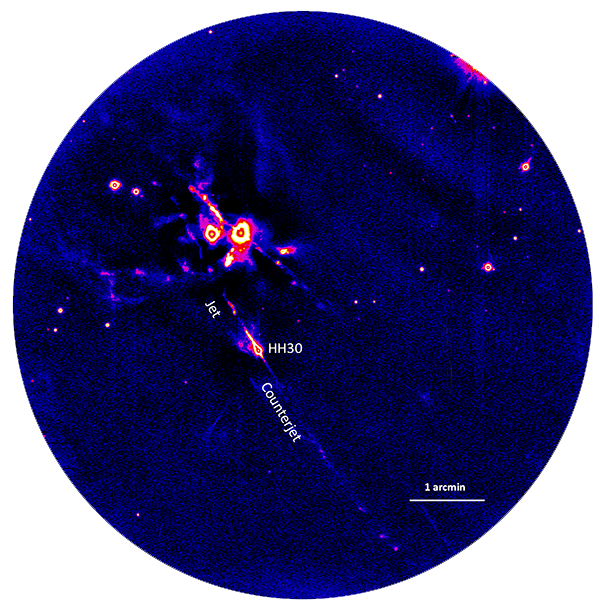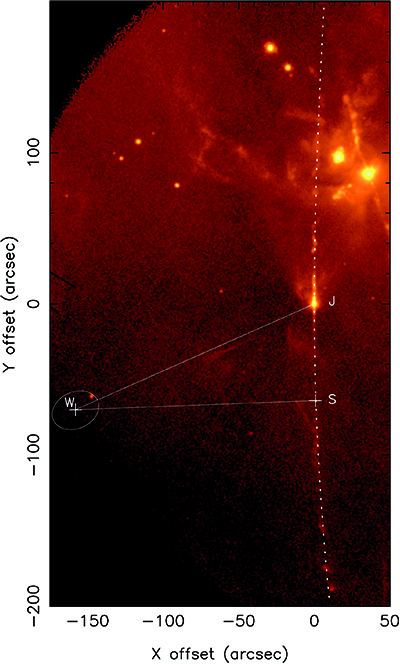The Herbig-Haro object 30 (HH30) is located in the
L1551 dark cloud, at a distance of about 140 parsec, in the Taurus star-forming
region. HH30 is considered a prototypical jet-disk system driven by a young
stellar object (YSO). The
impressive jet/counterjet structure extends several arcminutes in
both directions from the exciting source, and shows an undulating morphology in
the narrow-band [SII] images. The driving source of HH30 remains optically
invisible, highly extinguished by an edge-on disk, which extends up to a radius
of about 250 AU perpendiculary to the jet, as shown in the HST images.
In previous work (Anglada et al., 2007) astronomers were
able to fit the wiggling morphology of the HH30 jet using a model in which
the
driving source of the HH30 jet/counterjet forms part of a low-mass binary
system. This work is based on the
proper motions of the jet knots derived from two narrow-band [SII] images,
obtained at the NOT with ALFOSC, with a time span of 1 year.
The jet-wiggling
pattern is consistent with either by (1) the orbital motion of the jet source or
(2) precession of the jet axis because of tidal interaction with a companion
star. It would be possible to discriminate between these two scenarios if
the symmetry of the full jet/counterjet system could be analysed: in case of the
wiggling produced by orbital motion, a mirror ("C" shape) symmetry
with
respect to the equatorial plane is expected, while in the case of precession,
a point symmetry ("S" shape) with respect to the position of the driving
source is expected to be found. Unfortunately, the counterjet of HH30 is
much more weaker than the jet, and the NOT/ALFOSC images only covered a couple
of knots (the brightest knots, the closest to the source), and did not allow discrimination
between the two alternative scenarios.
The astronomers therefore obtained a deep image of the HH30 field
through a narrow-band [SII] filter using ACAM at the William Herschel Telescope,
which provides a wider field of view of 8 arcmin (see Figure 1), from which they were able to better determine the position and
the proper motion of the HH30 jet/counterjet system, and found that
the undulating pattern is a consequence of the orbital motion of a low-mass YSO binary
system of approximately 0.5 solar masses (Estalella et al., 2012). Precession, if present at all, is of secondary importance in
shaping the jet.
 |
Figure 1. Image obtained with ACAM at the WHT through the narrow-band [SII]
filter (λ c=6727Å, FWHM=50Å) showing the HH30 jet/counterjet
system at a position angle of 30°. The XZ/HL Tauri system is
also shown to the west of HH30. The total
exposure time of the image is 12000 seconds [ PNG ].
|
The derived orbital period is 114±2 years, the mass ratio,
2:1, and the binary separation, 18±0.6 AU. Interestingly, this separation
coincides with the value required to account for
the size of an inner hole observed at millimeter wavelengths, in the CO and
dust emission, in the disk
associated with HH30. This hole has been attributed to tidal truncation in a
binary system. Thus, contrary to what was initially thought,
the disk observed in the HST
images appears to be a circumbinary disk rather than a circumstellar disk, and is unlikely to have a relevant role
in the jet collimation.
The large-scale bending of the
jet/counterjet can be produced by an isotropic stellar wind from a nearby T Tauri star (see Figure 2).
 |
Figure 2. Close-up of Figure 1 showing the large-scale bending of the HH30
jet/counterjer system by an isotropic stellar wind. The dotted line shows the
best fit model. The positions of HH30 (J), the wind source (W) and
the stagnation point (S) are indicated [ JPG ].
|
References:
- Anglada, López, Estalella et al.,2007, AJ, 133, 2799.
- Estalella, López, Anglada et al., 2012, AJ, 144, 61.



